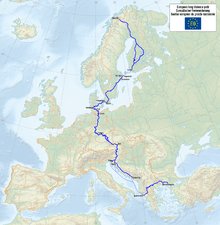E6 European long distance path
The E6 European long distance path or E6 path is one of the European long-distance paths from the northwest tip of Finland through Sweden, Denmark, Germany and Austria to the Adriatic coast in Slovenia. A second section starts again in Greece to finish in Turkey.

Finland
Responsible organisation: None
European Ramblers' Association doesn’t take the responsibility for E6 in Finland, because of no ERA Member Organisation in this country.
Some of the places passed on the north-to-south route include:
- Kilpisjärvi, Finland
- Kemi, Finland
- Tampere, Finland
- Turku, Finland
- Mariehamn, Finland
Sweden
Responsible organisation: Svenska Turistforeningen
Some of the places passed on the north-to-south route include:
- Grisslehamn, Sweden (reached by ferry)
- Stockholm, Sweden
- the lake country of S Sweden
- Malmö, Sweden
Denmark
Responsible organisation: Dansk Vandrelaug
Route
The E-path starts in Kastrup Airport in Copenhagen and follows the southern side of Copenhagen towards Roskilde.
An alternate E6 starts in Helsingør and follows Nordsjællandsruten to Roskilde. It goes through North Zealand and passes nationalpark Kongernes Nordsjælland.
From Roskilde the E-path follows partly the trail Skjoldungestien to Ringsted. From Ringsted to Korsør the E-path follows its own track. In Korsør you take the train over Great Belt to Nyborg, where the E-path continues south towards Svendborg, where it follows the trail Øhavsstien on the southern part of Fyn. Take the ferry from Svendborg to Ærøskøbing on the island Ærø and continue along Øhavsstien to Søby. Take the ferry from Søby to Fynshav, where you continue south to meet the Leading Quality Trail Gendarmstien. Follow Gendarmstien, passing Sønderborg and Gråsten towards Kruså.
The E-path is well documented on Waymarked Trails
The E-path is not well marked on Fyn !
- External links
Germany
Responsible organisation: Deutsche Wanderverband
Some of the places passed on the north-to-south route include:
- Kiel, Germany
- Lübeck, Germany
- Fichtelgebirge, Germany
- Dreisesselberg, Germany
Austria
Some of the places passed on the north-to-south route include:
- Eibiswald, Austria
- External links
Greece
Some of the places passed on the north-to-south route include:
- Igoumenitsa, Greece
- Florina, Greece
- Alexandroupoli, Greece
Turkey
Some of the places passed on the north-to-south route include:
- Dardanelles, Turkey
External links
| Wikimedia Commons has media related to E6 European long distance path. |